Abstract
1. The ionic mechanisms of rhythmic burst firing and single spike, tonic discharge were investigated with extracellular and intracellular recordings of single neurones in the guinea-pig nucleus reticularis thalami (NRT) maintained as a slice in vitro. 2. Activation of cortical/thalamic afferents to NRT neurones resulted in a short latency burst of action potentials which could be followed by a rhythmic sequence of oscillatory burst firing. Intracellularly, this oscillatory activity was associated with an alternating sequence of low threshold Ca2+ spikes separated by after-hyperpolarizing potentials. Intracellular injection of short duration hyperpolarizing current pulses resulted in a similar sequence of oscillatory burst firing, suggesting that this activity is an intrinsic property of NRT cells. The frequency of rhythmic burst firing was highly voltage and temperature dependent and was between 7-12 Hz at -65 to -60 mV at 38 degrees C. In addition, at depolarized membrane potentials, oscillatory burst firing was typically followed by a prolonged tail of single spike activity. 3. Application of the Na+ channel poison tetrodotoxin blocked the generation of fast action potentials, but left intact the rhythmic sequence of low threshold Ca2+ spikes separated by after-hyperpolarizing potentials (AHPs). The reversal potential of the AHPs was -94 mV, suggesting that it was mediated by an increase in K+ conductance. Extracellular application of tetraethylammonium or apamin, or intracellular injection of Cs+ or the Ca2+ chelating agent EGTA, blocked the Ca2+ spike AHP, indicating that it is mediated by a Ca(2+)-activated K+ current. 4. Block of the AHP resulted in the marked enhancement of a slow after-depolarizing potential (ADP). The slow ADP occurred only following the generation of low threshold Ca2+ spikes. Replacement of extracellular Ca2+ with Mg2+ or Sr2+ resulted in an abolition of the slow ADP. In addition, the increase in [Mg2+]o resulted in an abolition of the low threshold Ca2+ spike. In contrast, replacement of extracellular Ca2+ with Ba2+ did not abolish the slow ADP. These results indicate that the ADP can be activated by either Ca2+ or Ba2+, but not by Mg2+ or Sr2+. 5. Replacement of extracellular Na+ with choline+ did not abolish the slow ADP, while replacement with N-methyl-D-glucamine+ did, indicating that the slow ADP can be supported by choline+, but not by N-methyl-D-glucamine+. Neither chemical affected the low threshold Ca2+ spike. These results are consistent with the slow ADP being mediated by a Ca(2+)-activated non-selective cation (CAN) current.(ABSTRACT TRUNCATED AT 400 WORDS)
Full text
PDF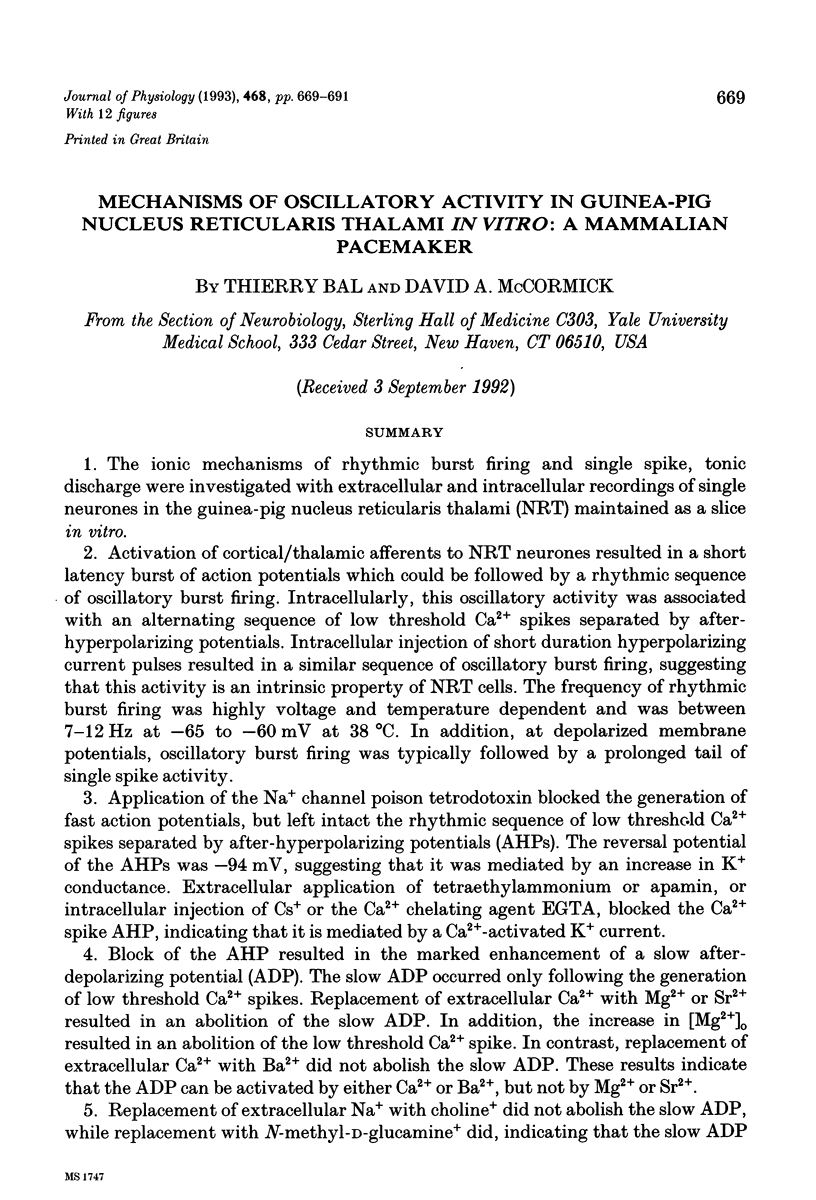

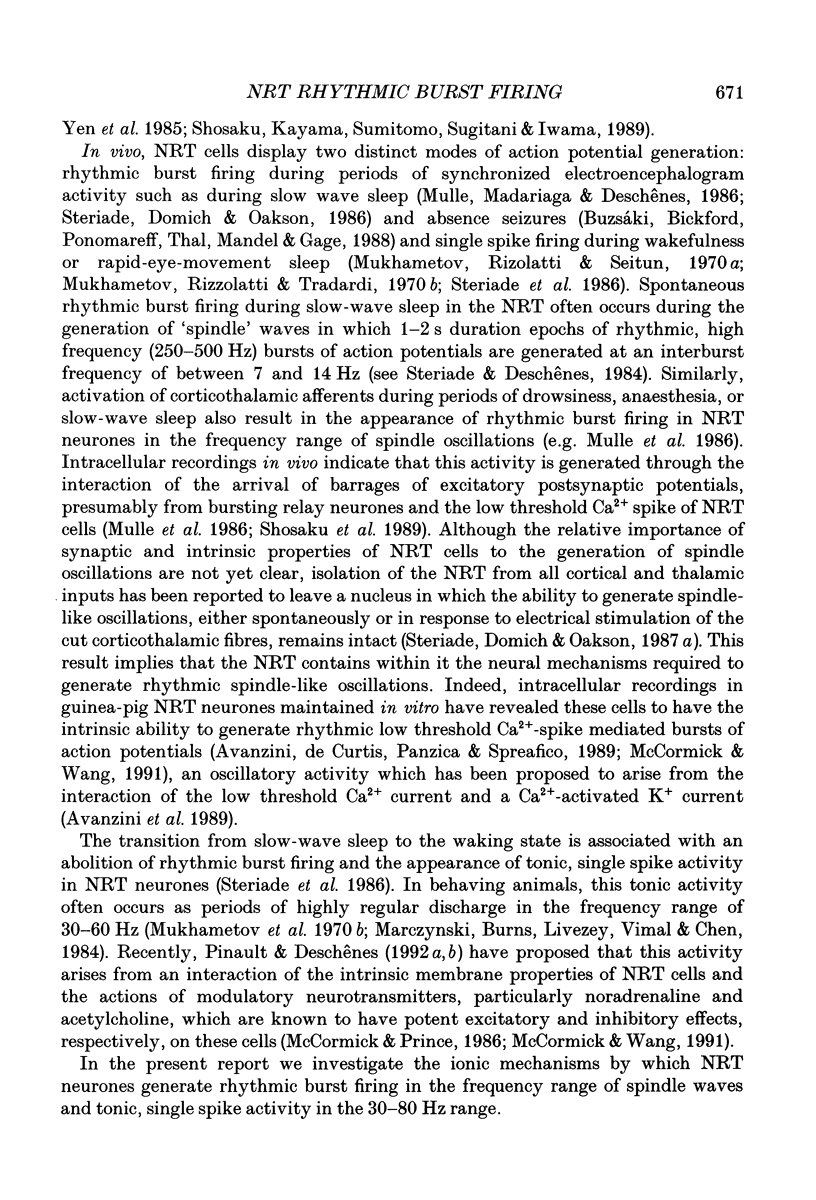
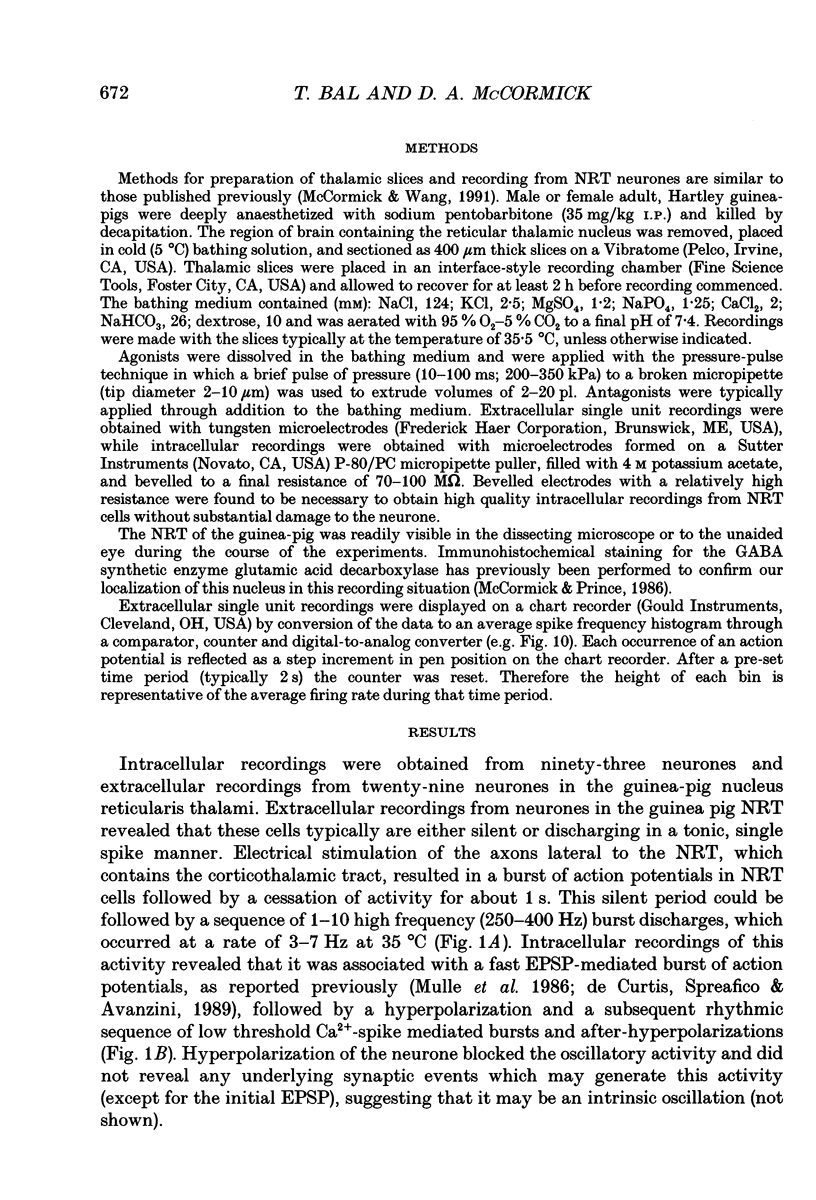

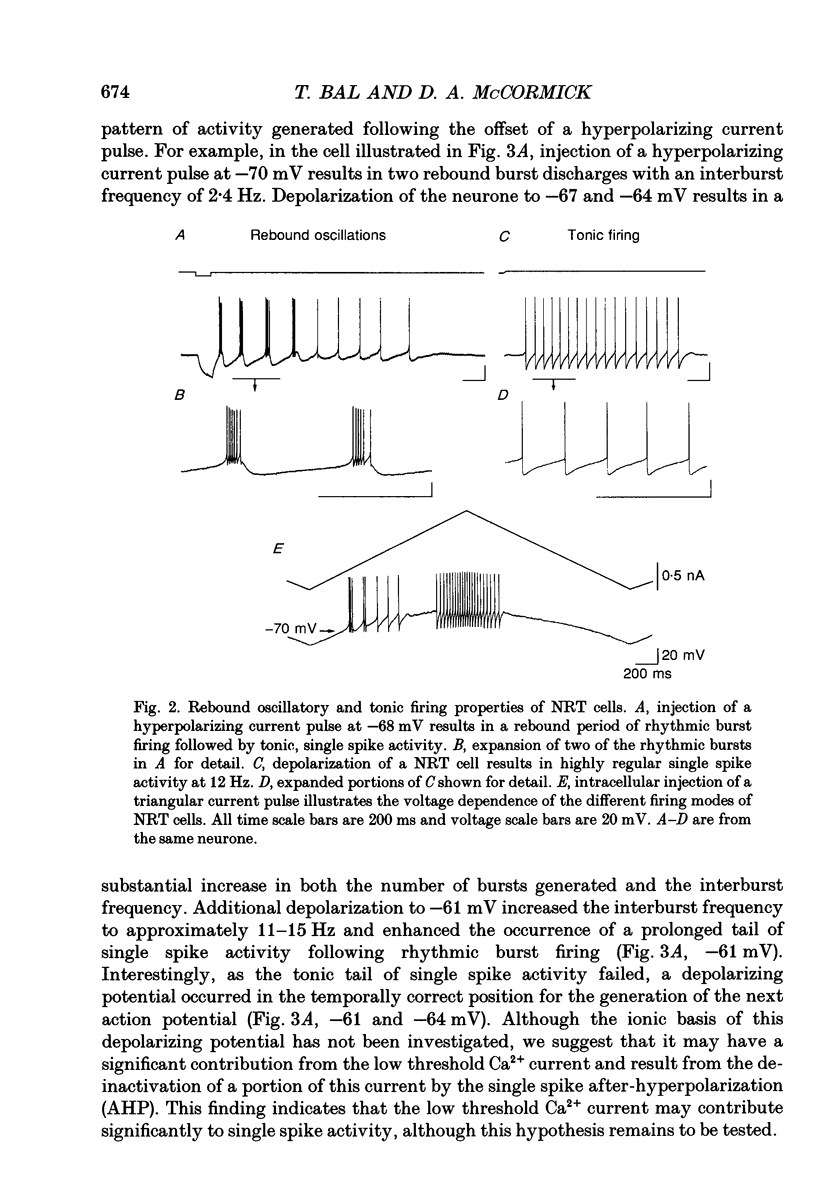







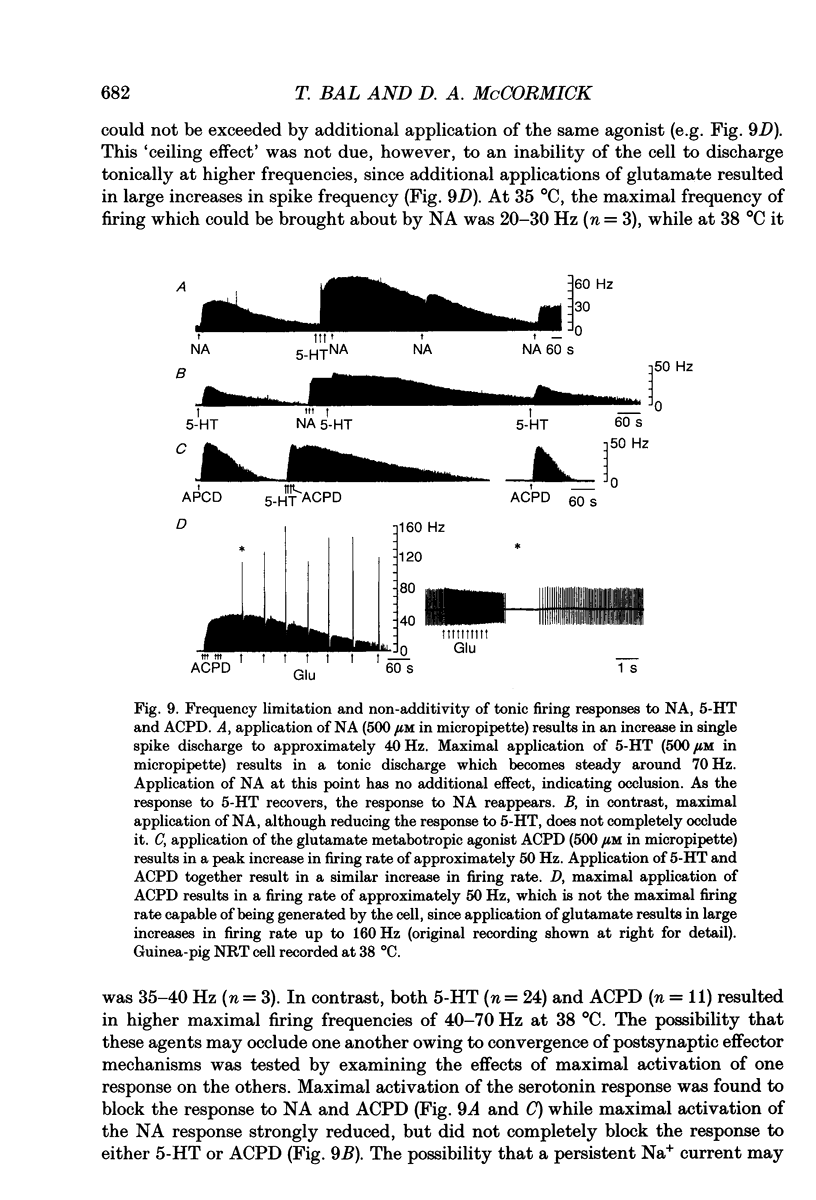
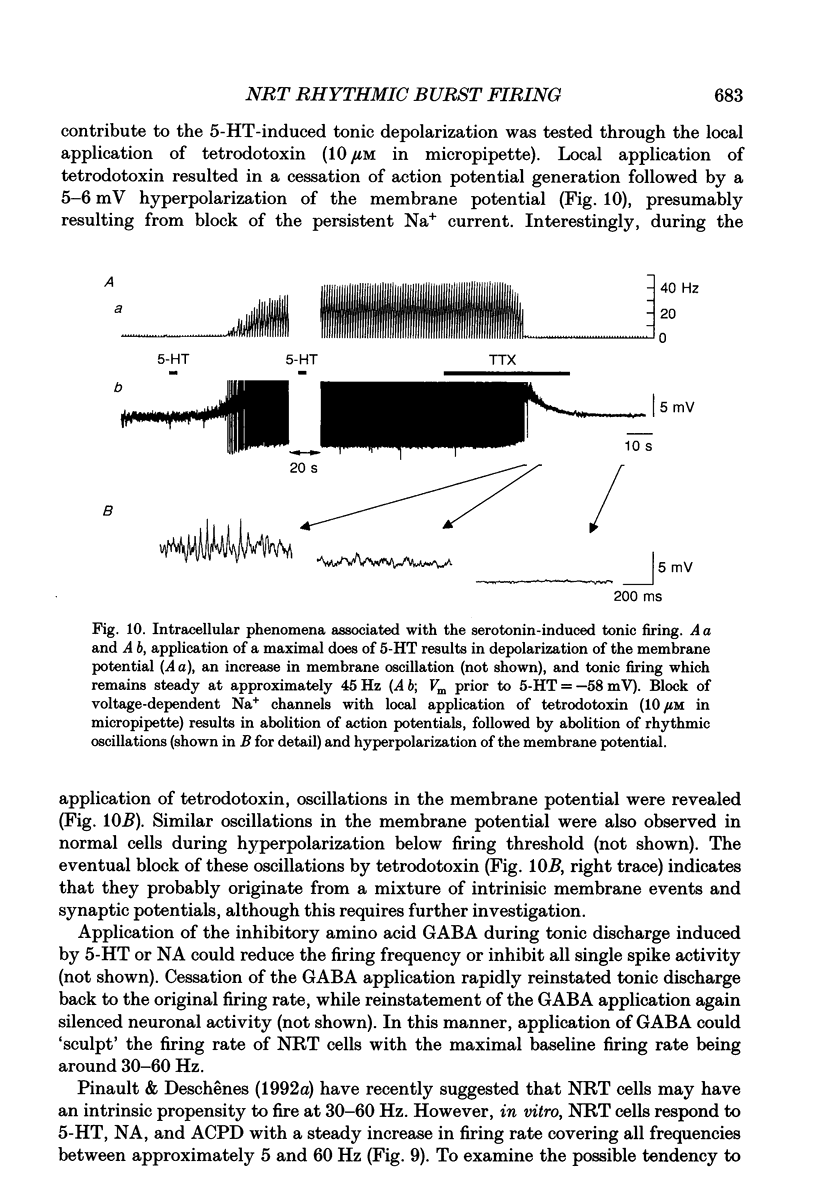
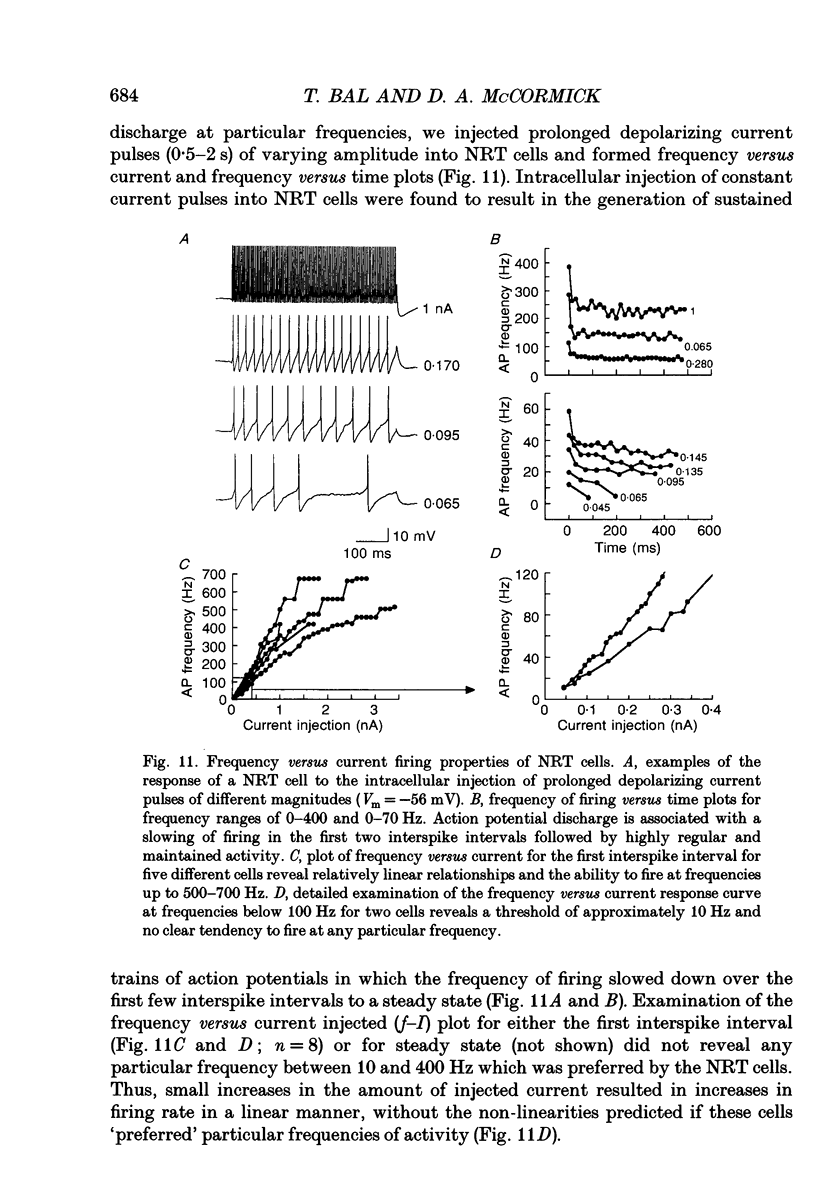





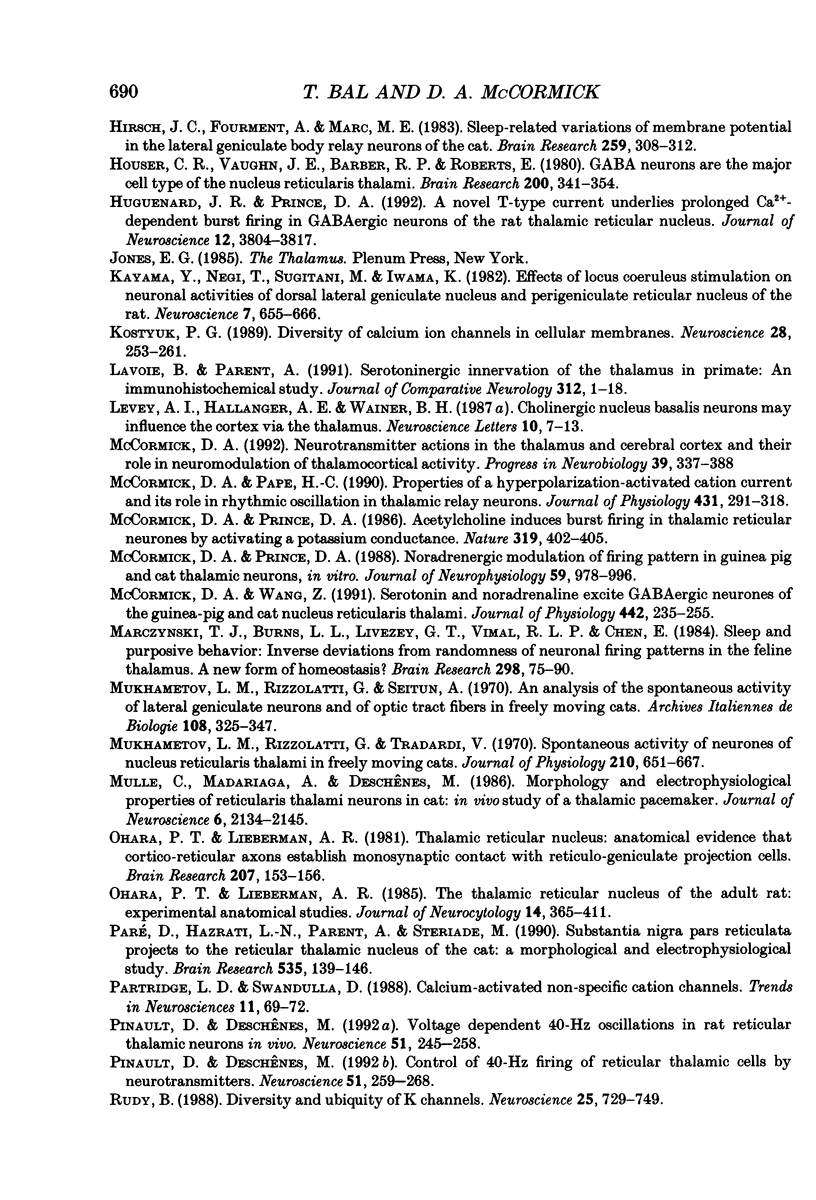
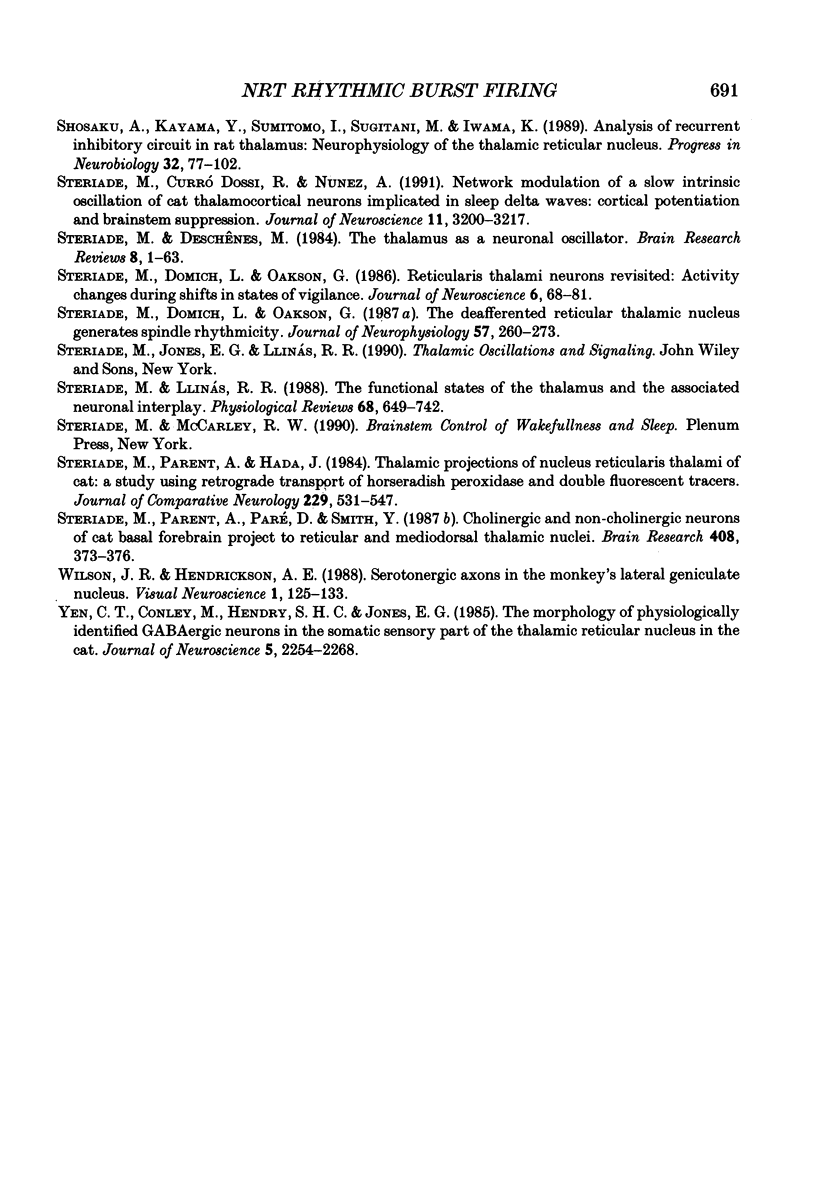
Selected References
These references are in PubMed. This may not be the complete list of references from this article.
- Asanuma C. Axonal arborizations of a magnocellular basal nucleus input and their relation to the neurons in the thalamic reticular nucleus of rats. Proc Natl Acad Sci U S A. 1989 Jun;86(12):4746–4750. doi: 10.1073/pnas.86.12.4746. [DOI] [PMC free article] [PubMed] [Google Scholar]
- Asanuma C. Noradrenergic innervation of the thalamic reticular nucleus: a light and electron microscopic immunohistochemical study in rats. J Comp Neurol. 1992 May 8;319(2):299–311. doi: 10.1002/cne.903190209. [DOI] [PubMed] [Google Scholar]
- Asanuma C., Porter L. L. Light and electron microscopic evidence for a GABAergic projection from the caudal basal forebrain to the thalamic reticular nucleus in rats. J Comp Neurol. 1990 Dec 1;302(1):159–172. doi: 10.1002/cne.903020112. [DOI] [PubMed] [Google Scholar]
- Avanzini G., de Curtis M., Panzica F., Spreafico R. Intrinsic properties of nucleus reticularis thalami neurones of the rat studied in vitro. J Physiol. 1989 Sep;416:111–122. doi: 10.1113/jphysiol.1989.sp017752. [DOI] [PMC free article] [PubMed] [Google Scholar]
- Buzsaki G., Bickford R. G., Ponomareff G., Thal L. J., Mandel R., Gage F. H. Nucleus basalis and thalamic control of neocortical activity in the freely moving rat. J Neurosci. 1988 Nov;8(11):4007–4026. doi: 10.1523/JNEUROSCI.08-11-04007.1988. [DOI] [PMC free article] [PubMed] [Google Scholar]
- Castle N. A., Haylett D. G., Jenkinson D. H. Toxins in the characterization of potassium channels. Trends Neurosci. 1989 Feb;12(2):59–65. doi: 10.1016/0166-2236(89)90137-9. [DOI] [PubMed] [Google Scholar]
- Crick F. Function of the thalamic reticular complex: the searchlight hypothesis. Proc Natl Acad Sci U S A. 1984 Jul;81(14):4586–4590. doi: 10.1073/pnas.81.14.4586. [DOI] [PMC free article] [PubMed] [Google Scholar]
- Domich L., Oakson G., Steriade M. Thalamic burst patterns in the naturally sleeping cat: a comparison between cortically projecting and reticularis neurones. J Physiol. 1986 Oct;379:429–449. doi: 10.1113/jphysiol.1986.sp016262. [DOI] [PMC free article] [PubMed] [Google Scholar]
- Hallanger A. E., Levey A. I., Lee H. J., Rye D. B., Wainer B. H. The origins of cholinergic and other subcortical afferents to the thalamus in the rat. J Comp Neurol. 1987 Aug 1;262(1):105–124. doi: 10.1002/cne.902620109. [DOI] [PubMed] [Google Scholar]
- Harris R. M. Axon collaterals in the thalamic reticular nucleus from thalamocortical neurons of the rat ventrobasal thalamus. J Comp Neurol. 1987 Apr 15;258(3):397–406. doi: 10.1002/cne.902580308. [DOI] [PubMed] [Google Scholar]
- Hazrati L. N., Parent A. Projection from the external pallidum to the reticular thalamic nucleus in the squirrel monkey. Brain Res. 1991 May 31;550(1):142–146. doi: 10.1016/0006-8993(91)90418-u. [DOI] [PubMed] [Google Scholar]
- Hirsch J. C., Fourment A., Marc M. E. Sleep-related variations of membrane potential in the lateral geniculate body relay neurons of the cat. Brain Res. 1983 Jan 24;259(2):308–312. doi: 10.1016/0006-8993(83)91264-7. [DOI] [PubMed] [Google Scholar]
- Houser C. R., Vaughn J. E., Barber R. P., Roberts E. GABA neurons are the major cell type of the nucleus reticularis thalami. Brain Res. 1980 Nov 3;200(2):341–354. doi: 10.1016/0006-8993(80)90925-7. [DOI] [PubMed] [Google Scholar]
- Huguenard J. R., Prince D. A. A novel T-type current underlies prolonged Ca(2+)-dependent burst firing in GABAergic neurons of rat thalamic reticular nucleus. J Neurosci. 1992 Oct;12(10):3804–3817. doi: 10.1523/JNEUROSCI.12-10-03804.1992. [DOI] [PMC free article] [PubMed] [Google Scholar]
- Kayama Y., Negi T., Sugitani M., Iwama K. Effects of locus coeruleus stimulation on neuronal activities of dorsal lateral geniculate nucleus and perigeniculate reticular nucleus of the rat. Neuroscience. 1982 Mar;7(3):655–666. doi: 10.1016/0306-4522(82)90071-9. [DOI] [PubMed] [Google Scholar]
- Kostyuk P. G. Diversity of calcium ion channels in cellular membranes. Neuroscience. 1989;28(2):253–261. doi: 10.1016/0306-4522(89)90177-2. [DOI] [PubMed] [Google Scholar]
- Lavoie B., Parent A. Serotoninergic innervation of the thalamus in the primate: an immunohistochemical study. J Comp Neurol. 1991 Oct 1;312(1):1–18. doi: 10.1002/cne.903120102. [DOI] [PubMed] [Google Scholar]
- Levey A. I., Hallanger A. E., Wainer B. H. Cholinergic nucleus basalis neurons may influence the cortex via the thalamus. Neurosci Lett. 1987 Feb 10;74(1):7–13. doi: 10.1016/0304-3940(87)90042-5. [DOI] [PubMed] [Google Scholar]
- Marczynski T. J., Burns L. L., Livezey G. T., Vimal R. L., Chen E. Sleep and purposive behavior: inverse deviations from randomness of neuronal firing patterns in the feline thalamus. A new form of homeostasis? Brain Res. 1984 Apr 23;298(1):75–90. doi: 10.1016/0006-8993(84)91148-x. [DOI] [PubMed] [Google Scholar]
- McCormick D. A. Neurotransmitter actions in the thalamus and cerebral cortex and their role in neuromodulation of thalamocortical activity. Prog Neurobiol. 1992 Oct;39(4):337–388. doi: 10.1016/0301-0082(92)90012-4. [DOI] [PubMed] [Google Scholar]
- McCormick D. A., Pape H. C. Properties of a hyperpolarization-activated cation current and its role in rhythmic oscillation in thalamic relay neurones. J Physiol. 1990 Dec;431:291–318. doi: 10.1113/jphysiol.1990.sp018331. [DOI] [PMC free article] [PubMed] [Google Scholar]
- McCormick D. A., Prince D. A. Acetylcholine induces burst firing in thalamic reticular neurones by activating a potassium conductance. 1986 Jan 30-Feb 5Nature. 319(6052):402–405. doi: 10.1038/319402a0. [DOI] [PubMed] [Google Scholar]
- McCormick D. A., Prince D. A. Noradrenergic modulation of firing pattern in guinea pig and cat thalamic neurons, in vitro. J Neurophysiol. 1988 Mar;59(3):978–996. doi: 10.1152/jn.1988.59.3.978. [DOI] [PubMed] [Google Scholar]
- McCormick D. A., Wang Z. Serotonin and noradrenaline excite GABAergic neurones of the guinea-pig and cat nucleus reticularis thalami. J Physiol. 1991 Oct;442:235–255. doi: 10.1113/jphysiol.1991.sp018791. [DOI] [PMC free article] [PubMed] [Google Scholar]
- Mukhametov L. M., Rizzolatti G., Seitun A. An analysis of the spontaneous activity of lateral geniculate neurons and of optic tract fibers in free moving cats. Arch Ital Biol. 1970 Apr;108(2):325–347. [PubMed] [Google Scholar]
- Mukhametov L. M., Rizzolatti G., Tradardi V. Spontaneous activity of neurones of nucleus reticularis thalami in freely moving cats. J Physiol. 1970 Oct;210(3):651–667. doi: 10.1113/jphysiol.1970.sp009233. [DOI] [PMC free article] [PubMed] [Google Scholar]
- Mulle C., Madariaga A., Deschênes M. Morphology and electrophysiological properties of reticularis thalami neurons in cat: in vivo study of a thalamic pacemaker. J Neurosci. 1986 Aug;6(8):2134–2145. doi: 10.1523/JNEUROSCI.06-08-02134.1986. [DOI] [PMC free article] [PubMed] [Google Scholar]
- Mulle C., Steriade M., Deschênes M. Absence of spindle oscillations in the cat anterior thalamic nuclei. Brain Res. 1985 May 13;334(1):169–171. doi: 10.1016/0006-8993(85)90581-5. [DOI] [PubMed] [Google Scholar]
- Ohara P. T., Lieberman A. R. Thalamic reticular nucleus: anatomical evidence that cortico-reticular axons establish monosynaptic contact with reticulo-geniculate projection cells. Brain Res. 1981 Feb 23;207(1):153–156. doi: 10.1016/0006-8993(81)90685-5. [DOI] [PubMed] [Google Scholar]
- Ohara P. T., Lieberman A. R. The thalamic reticular nucleus of the adult rat: experimental anatomical studies. J Neurocytol. 1985 Jun;14(3):365–411. doi: 10.1007/BF01217752. [DOI] [PubMed] [Google Scholar]
- Partridge L. D., Swandulla D. Calcium-activated non-specific cation channels. Trends Neurosci. 1988 Feb;11(2):69–72. doi: 10.1016/0166-2236(88)90167-1. [DOI] [PubMed] [Google Scholar]
- Paré D., Hazrati L. N., Parent A., Steriade M. Substantia nigra pars reticulata projects to the reticular thalamic nucleus of the cat: a morphological and electrophysiological study. Brain Res. 1990 Dec 3;535(1):139–146. doi: 10.1016/0006-8993(90)91832-2. [DOI] [PubMed] [Google Scholar]
- Pinault D., Deschênes M. Control of 40-Hz firing of reticular thalamic cells by neurotransmitters. Neuroscience. 1992 Nov;51(2):259–268. doi: 10.1016/0306-4522(92)90313-q. [DOI] [PubMed] [Google Scholar]
- Pinault D., Deschênes M. Voltage-dependent 40-Hz oscillations in rat reticular thalamic neurons in vivo. Neuroscience. 1992 Nov;51(2):245–258. doi: 10.1016/0306-4522(92)90312-p. [DOI] [PubMed] [Google Scholar]
- Rudy B. Diversity and ubiquity of K channels. Neuroscience. 1988 Jun;25(3):729–749. doi: 10.1016/0306-4522(88)90033-4. [DOI] [PubMed] [Google Scholar]
- Shosaku A., Kayama Y., Sumitomo I., Sugitani M., Iwama K. Analysis of recurrent inhibitory circuit in rat thalamus: neurophysiology of the thalamic reticular nucleus. Prog Neurobiol. 1989;32(2):77–102. doi: 10.1016/0301-0082(89)90011-7. [DOI] [PubMed] [Google Scholar]
- Steriade M., Deschenes M. The thalamus as a neuronal oscillator. Brain Res. 1984 Nov;320(1):1–63. doi: 10.1016/0165-0173(84)90017-1. [DOI] [PubMed] [Google Scholar]
- Steriade M., Domich L., Oakson G., Deschênes M. The deafferented reticular thalamic nucleus generates spindle rhythmicity. J Neurophysiol. 1987 Jan;57(1):260–273. doi: 10.1152/jn.1987.57.1.260. [DOI] [PubMed] [Google Scholar]
- Steriade M., Domich L., Oakson G. Reticularis thalami neurons revisited: activity changes during shifts in states of vigilance. J Neurosci. 1986 Jan;6(1):68–81. doi: 10.1523/JNEUROSCI.06-01-00068.1986. [DOI] [PMC free article] [PubMed] [Google Scholar]
- Steriade M., Dossi R. C., Nuñez A. Network modulation of a slow intrinsic oscillation of cat thalamocortical neurons implicated in sleep delta waves: cortically induced synchronization and brainstem cholinergic suppression. J Neurosci. 1991 Oct;11(10):3200–3217. doi: 10.1523/JNEUROSCI.11-10-03200.1991. [DOI] [PMC free article] [PubMed] [Google Scholar]
- Steriade M., Llinás R. R. The functional states of the thalamus and the associated neuronal interplay. Physiol Rev. 1988 Jul;68(3):649–742. doi: 10.1152/physrev.1988.68.3.649. [DOI] [PubMed] [Google Scholar]
- Steriade M., Parent A., Hada J. Thalamic projections of nucleus reticularis thalami of cat: a study using retrograde transport of horseradish peroxidase and fluorescent tracers. J Comp Neurol. 1984 Nov 10;229(4):531–547. doi: 10.1002/cne.902290407. [DOI] [PubMed] [Google Scholar]
- Steriade M., Parent A., Paré D., Smith Y. Cholinergic and non-cholinergic neurons of cat basal forebrain project to reticular and mediodorsal thalamic nuclei. Brain Res. 1987 Apr 7;408(1-2):372–376. doi: 10.1016/0006-8993(87)90408-2. [DOI] [PubMed] [Google Scholar]
- Wilson J. R., Hendrickson A. E. Serotonergic axons in the monkey's lateral geniculate nucleus. Vis Neurosci. 1988;1(1):125–133. doi: 10.1017/s0952523800001061. [DOI] [PubMed] [Google Scholar]
- Yen C. T., Conley M., Hendry S. H., Jones E. G. The morphology of physiologically identified GABAergic neurons in the somatic sensory part of the thalamic reticular nucleus in the cat. J Neurosci. 1985 Aug;5(8):2254–2268. doi: 10.1523/JNEUROSCI.05-08-02254.1985. [DOI] [PMC free article] [PubMed] [Google Scholar]
- de Curtis M., Spreafico R., Avanzini G. Excitatory amino acids mediate responses elicited in vitro by stimulation of cortical afferents to reticularis thalami neurons of the rat. Neuroscience. 1989;33(2):275–283. doi: 10.1016/0306-4522(89)90207-8. [DOI] [PubMed] [Google Scholar]


